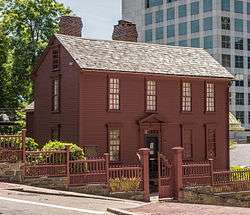Governor Stephen Hopkins House
The Governor Stephen Hopkins House is a museum and National Historic Landmark at 15 Hopkins Street in Providence, Rhode Island. The house was the home of Stephen Hopkins, a governor of Rhode Island and signatory of the Declaration of Independence.
Governor Stephen Hopkins House | |
U.S. National Historic Landmark District Contributing Property | |
 | |
| Location | Providence, RI |
|---|---|
| Coordinates | 41°49′18″N 71°24′12″W |
| Built | 1708 or 1742[1] |
| Part of | College Hill Historic District (ID70000019) |
| NRHP reference No. | 70000022 |
| Significant dates | |
| Added to NRHP | April 3, 1970[1] |
| Designated NHL | November 11, 1978[2] |
| Designated NHLDCP | November 10, 1970 |
Description
_(cropped).jpg)
The Stephen Hopkins House is an L-shaped, 2½-story, wood-framed structure whose main block was built in 1742–43 for Hopkins, with an attached two-story ell whose first floor dates to 1707. The main block is four bays wide and two deep, with the main entrance in the second bay from the left. This entry is a 20th-century alteration; the original main entrance was through a doorway on the west side of the ell.[3]
The interior of the main block has the main parlor on the right and Governor Hopkins' study on the left, flanking a central hallway with stair. Behind the parlor is a keeping room, with a small bedchamber behind the study. There are five bedrooms on the second floor, two with fireplaces. The downstairs fireplace mantels are paneled, with the one in the parlor slightly more elaborate.[3]
History
The 1707 house was purchased by Stephen Hopkins in 1742 and enlarged into its present size. It served as his home until his death in 1785. During these years, he served in the colonial assembly, as a justice (first associate, then chief) of the colonial high court, and as governor of the Colony of Rhode Island from 1755 to 1757. The house is the only significant structure associated with Hopkins' life.[3]
George Washington visited the house on April 5, 1776 while traveling through Providence on his way to take command of the Continental Army in Boston.[4] Washington was entertained by Hopkins' daughter, as Hopkins was in Philadelphia attending the Continental Congress at the time.[4]
The house was originally built on the northeast corner of South Main Street (formerly Towne Street) and Hopkins Street (formerly Bank Lane).[5][6] In 1809 the house was moved halfway up the north side of Hopkins Street.[5][6] It was moved again in 1928 to its present location on Hopkins Street.[5]
In the late 1920s, the house was carefully restored by Norman Isham.[5] It is now owned and managed by The National Society of the Colonial Dames of America and is a museum open to the public.[3] It was listed on the National Register of Historic Places in 1970,[1] and declared a National Historic Landmark in 1978.[2][3]
Gallery
 Back elevation of the house in 1918
Back elevation of the house in 1918 Front elevation in 2008
Front elevation in 2008 NRHP plaque on the exterior of the house
NRHP plaque on the exterior of the house Rear of the house, showing garden area
Rear of the house, showing garden area
See also
- List of National Historic Landmarks in Rhode Island
- National Register of Historic Places in Providence, Rhode Island
References
- "National Register Information System". National Register of Historic Places. National Park Service. April 15, 2008.
- "Hopkins, Governor Stephen, House". National Historic Landmark summary listing. National Park Service. Archived from the original on 2012-10-07. Retrieved 2008-06-28.
- Snell, George (1971). "National Register of Historic Places Inventory-Nomination: Gov. Stephen Hopkins House" (pdf). National Park Service. Cite journal requires
|journal=(help) and Accompanying 4 photos, exterior and interior, from 1971 (32 KB) - Parker, HL (4 July 2011). "George Washington Slept Here". Providence Daily Dose. Retrieved 9 May 2019.
General Washington’s first visit was on April 5, 1776. He was on his way to take command of the Continental Army in Boston. Hopkins himself was in Philadelphia, at the Continental Congress.
- "The Stephen Hopkins House and Hopkins Street". Architecture and Memory. Joukowsky Institute. Retrieved 9 May 2019.
- Kimball, Gertrude Selwyn (1912). Providence in Colonial Times. Houghton Mifflin. pp. 209–212. Retrieved 9 May 2019.
stephen hopkins house up the hill.